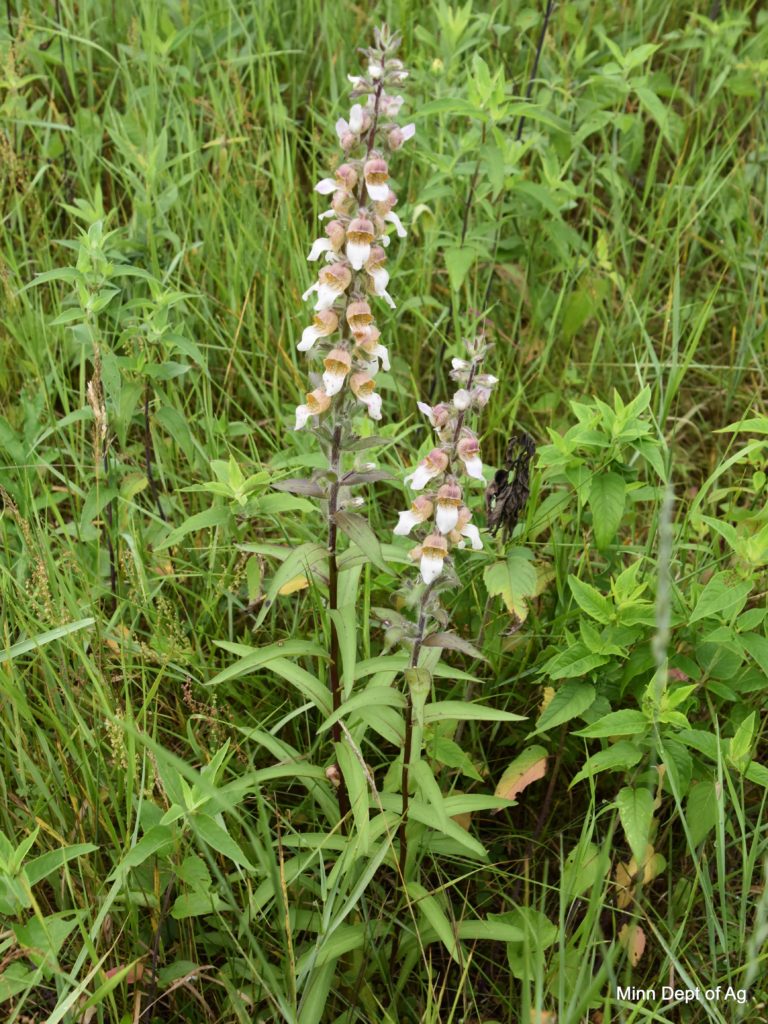| Grecian foxglove (Digitalis lanata) is a beautiful but toxic invasive plant. It was brought to North America from its native Europe as an ornamental plant. Grecian foxglove thrives in sunny to partially shaded areas and has been found in Washington County, Minnesota. All plant parts are toxic, alive or dried, necessitating careful handling with protective clothing and equipment. This is a threat to humans and other animals. Additionally, Grecian foxglove overtakes and unbalances the ecosystems it takes root in.Grecian foxglove is a perennial plant that forms a rosette then sends up a flowering stem its second and subsequent years. The flowering stems are 2-5 feet tall. Its leaves are oblong-shaped with pointed tips and are simple and alternately placed on the stem. Flower color ranges from white to faint yellow with brownish-purple venation inside. Some of the ways Grecian foxglove can be distinguished from its look alike, common or garden foxglove (Digitalis purpurea), is that Grecian Foxglove has woolly hairs located on the stems and sepals, green petals that surround and protect the flower bud, and garden foxglove’s flowers display a much wider color spectrum. |
Grecian foxglove (Digitalis lanata) is a beautiful but toxic invasive plant. It was brought to North America from its native Europe as an ornamental plant. The noxious weed thrives in sunny to partially-shaded areas and has been found in Washington County, Minnesota. All plant parts are toxic, whether it’s alive and thriving or dead and dried out, which means you have to take precautions. Careful handling with protective clothing and equipment is vital to your safety. This is a threat to humans and animals. Additionally, the weed overtakes and unbalances the ecosystems it takes root in, squeezing out other non-invasive plants.
Grecian foxglove synthesizes toxic compounds that impact cardiovascular, neurological and gastrointestinal systems. The poison effects can come after either accidental ingestion or absorption through the skin. Poison symptoms include headache, nausea, vomiting, lethargy, abdominal pain, strange dreams, arrhythmias, and changes in vision.

Please take this seriously. If you suspect foxglove poisoning, call Minnesota Poison Control System at 1-800-222-1222. Obviously, if someone needs immediate help, call 911 if immediate help is needed.
These toxic compounds can be deadly, but when extracted and used properly, they can also be used as a medicine. They can be highly beneficial in treating cardiac arrhythmia, a condition that causes the heart to beat irregularly.
The Minnesota Department of Agriculture (MDA), Washington Conservation District, along with the Conservation Corps of Minnesota (CCM), University of Minnesota-Extension, Belwin Conservancy, and private landowners and contractors are all working together to find and eliminate foxglove in Minnesota.
These groups and their efforts are supported by Environment and Natural Resources Trust Funds, as recommended by the Legislative-Citizens Commission on Minnesota Resources. Grecian foxglove is a prohibited and eradicate weed on the Minnesota Noxious Weed List. If you suspect that you have found Grecian Foxglove, please take pictures of the plant, note the exact location, and report to Arrest the Pest at arrest.the.pest@state.mn.us.
